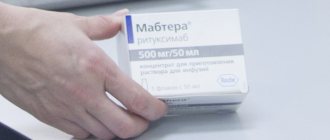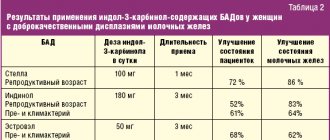Composition per capsule:
Active substance:
itraconazole pellets - 464.00 mg, containing itraconazole - 100.00 mg.
Excipients included in
itraconazole pellets:
sugar pellets - 207.44 mg (sucrose - 80.0 - 91.5%, corn starch - 8.5 - 20.0%, water - maximum 1.5%), hypromellose - 130.11 mg, poloxamer 188 (Lutrol F68) - 25.94 mg, micronized poloxamer 188 (Lutrol micro 68) - 0.51 mg.
Hard gelatin capsules:
water – 13-16%, sunset yellow dye (E110) – 1%, titanium dioxide – 1%, gelatin – up to 100%.
Description
Hard gelatin capsules No. 0 are orange in color, containing spherical microgranules (pellets) from light yellow to yellowish-beige.
Pharmacotherapeutic group.
Antifungal agent
ATX code
[J02AC02]
Pharmacological properties
Pharmacodynamics
Itraconazole, a triazole derivative, is active against infections caused by dermatophytes (Trichophyton spp., Microsporum spp., Epidermophyton floccosum), yeast-like fungi and yeasts (Candida spp., including C.albicans, C.glabrata and C.krusei, Cryptococcus neoformans, Pityrosporum spp., Trichosporon spp., Geotrichum spp.); Aspergillus spp., Histoplasma spp., Paracoccidioides brasiliensis, Sporothrix schenckii, Fonsecaea spp., Cladosporium spp., Blastomyces dermatitidis, Pseudallescheria boydii, Penicillium marneffei, as well as other yeasts and molds.
Itraconazole disrupts the synthesis of ergosterol, which is an important component of the cell membrane of fungi, which determines the antifungal effect of the drug.
Pharmacokinetics
When administered orally, maximum bioavailability of itraconazole is observed when capsules are taken immediately after meals. Maximum plasma concentrations are achieved within 3-4 hours after oral administration. Elimination from plasma is biphasic with a terminal half-life of 24-36 hours. With long-term use, equilibrium concentration is achieved within 1-2 weeks. The equilibrium concentration of itraconazole in plasma 3-4 hours after taking the drug is 0.4 mcg/ml (100 mg when taken once a day), 1.1 mcg/ml (200 mg when taken once a day) and 2. 0 mcg/ml (200 mg when taken twice daily). Itraconazole is 99.8% bound to plasma proteins. The concentration of itraconazole in the blood is 60% of the concentration in plasma.
The accumulation of the drug in keratin tissues, especially in the skin, is approximately 4 times higher than the accumulation in plasma, and the rate of its elimination depends on the regeneration of the epidermis.
In contrast to plasma concentrations, which are undetectable 7 days after cessation of therapy, therapeutic skin concentrations persist for 2-4 weeks after cessation of a 4-week course of treatment. Itraconazole is detectable in nail keratin as early as one week after initiation of treatment and persists for at least 6 months after completion of 3 months of therapy. Itraconazole is also detected in sebum and, to a lesser extent, in sweat.
Itraconazole is well distributed in tissues that are susceptible to fungal infections. Concentrations in the lungs, kidneys, liver, bones, stomach, spleen and muscles were two to three times higher than the corresponding plasma concentrations. Therapeutic concentrations in vaginal tissues remain for another 2 days after the end of a 3-day course of treatment at a dose of 200 mg per day, and 3 days after the end of a one-day course of treatment at a dose of 200 mg twice a day.
Itraconazole is metabolized by the liver to form a large number of metabolites. One such metabolite is hydroxy-itraconazole, which has antifungal activity comparable to itraconazole in vitro. Antifungal concentrations of the drug determined by microbiological methods were approximately 3 times higher than those measured by HPLC. Excretion in feces ranges from 3 to 18% of the dose. Renal excretion is less than 0.03% of the dose. Approximately 35% of the dose is excreted as metabolites in the urine within 1 week.
Since the total half-life of itraconazole and its plasma concentration are slightly increased in patients with renal failure, dose adjustment may be required (see section "Special Instructions").
Since the total half-life of itraconazole and its plasma concentration are slightly increased in patients with cirrhosis, dose adjustment may be required (see section "Special Instructions").
Overdose and acute toxicity of itraconazole in cats, dogs and other animal species
Information regarding the acute toxicity of itraconazole is very limited.
According to the instructions, oral administration of antacids will help reduce absorption. In case of significant overdoses, bowel cleansing should be performed and, if necessary, maintenance treatment should be prescribed. Itraconazole cannot be removed by dialysis.
Studies in dogs given itraconazole 40 mg/kg orally daily for 3 months showed no apparent signs of toxicity.
Drug interactions For best absorption of itraconazole, an acidic environment is required, so antacids, H2-blockers (cimetvdine, ranitidine, etc.) or didanosine can cause a marked decrease in the absorption of itraconazole. Didanosine should not be prescribed simultaneously with itraconazole; the other drugs listed above can be given 2 hours after itraconazole administration, if necessary.
Itraconazole may increase prothrombin time in cats, dogs, and other pet species
receiving warfarin or other coumarin anticoagulants. Rifampin (rifampicin) may increase the rate of metabolism of itraconazole, so dose adjustment of the latter is recommended.
According to the instructions for use, itraconazole may reduce the metabolism of phenytoin or cyclosporine. The veterinary significance of this interaction is unclear.
Intraconazole, when prescribed concomitantly with terfenadine or yastemizole, may increase the likelihood of cardiovascular disorders, so if itraconazole is necessary, the best option is to use another antihistamine.
Intraconazole may increase serum concentrations of digoxin in animals; Monitoring serum digoxin levels is recommended.
According to the label, itraconazole increases serum concentrations of oral antidiabetic drugs in dogs and cats (eg, chlorpropamide, glipizide), which can lead to hypoglycemia.
Co-administration of ketoconazole, itraconazole, intravenous miconazole or troleandomycin with cisapride may lead to an increase in the concentration of the latter with subsequent ventricular arrhythmia. At this time, the manufacturer states that cisapride should not be co-administered with these drugs.
Effects on Laboratory Values Itraconazole may cause hypokalemia or, in a small percentage of patients, increased results on liver function tests.
Indications for use
- dermatomycosis;
- fungal keratitis;
- onychomycosis caused by dermatophytes and/or yeasts and molds;
- systemic mycoses:
- systemic aspergillosis and candidiasis,
- cryptococcosis (including cryptococcal meningitis): In immunocompromised patients and all patients with central nervous system cryptococcosis, Itraconazole capsules should only be prescribed when first-line treatment is not appropriate or effective.
- histoplasmosis,
- sporotrichosis,
- paracoccidioidomycosis,
- blastomycosis
- other rare systemic or tropical mycoses;
- candidomycosis with damage to the skin or mucous membranes, including vulvovaginal candidiasis;
- pityriasis versicolor.
Side effects
Itraconazole can cause allergic reactions, thrombocytopenia , serum sickness, leukopenia , anaphylactoid reactions, hypertriglyceridemia , hypokalemia .
Nervous system: hypersthesia , paresthesia , dizziness , peripheral neuropathy .
Respiratory system: pulmonary edema .
Digestive tract: diarrhea , dyspeptic disorders, hepatotoxicity , increased liver enzymes, vomiting, constipation , hepatitis , impaired taste perception, hyperbilirubinemia , epigastric pain.
Sense organs: tinnitus, permanent deafness, blurred vision, diplopia .
Possible development of arthralgia, myalgia , urinary incontinence, pollakiuria, erectile dysfunction , menstrual irregularities, swelling.
Contraindications
- hypersensitivity to itraconazole and any of the components of the drug.
- Concomitant use of the following drugs with Itraconazole capsules:
- simultaneous use of CYP3A4 isoenzyme substrates that prolong the QT interval (astemizole, bepridil, cisapride, dofetilide, levacetylmethadol, mizolastine, pimozide, quinidine, sertindole, terfenadine)
- HMG-Coa reductase inhibitors metabolized by the CYP3A4 isoenzyme (lovastatin, simvastatin);
- simultaneous oral administration of triazolam and midazolam, nisoldipine, eletriptan;
- ergot alkaloid preparations such as dihydroergotamine, ergometrine,
- ergotamine and methylergometrine;
- fructose intolerance, sucrase/isomaltase deficiency, glucose-galactose malabsorption;
- children under 3 years of age;
- pregnancy and lactation
Carefully
– with cirrhosis of the liver, chronic renal failure, chronic heart failure, hypersensitivity to other azoles, in children and elderly patients (see also section “Special instructions”).
Interaction
Absorption of the drug is disrupted when drugs that reduce the acidity of gastric juice are simultaneously introduced into the body.
Phenytoin , Rifampicin , Rifabutin and other inducers of the CYP3A4 isoenzyme impair the bioavailability of the antifungal agent. Inhibitors of this enzyme have the opposite effect.
When prescribing BMCC, antitumor agents ( trimetrexate , docetaxel , busulfan , vinca alkaloids), immunosuppressants ( sirolimus , Tacrolimus ), corticosteroids, digoxin, and indirect anticoagulants, caution must be exercised.
Treatment regimens and possible dosages
Itraconazole tablets are taken orally, swallowing them whole with a small amount of water. The optimal time to take is after a meal.
A detailed regimen for taking Itraconazole should be found in the instructions for use; it is also possible to prescribe a personal regimen and select dosages at the discretion of the doctor.
Itraconazole is usually taken according to the following instructions:
- vulvovaginal candidiasis - 200 mg twice a day, duration of administration is 1 day, or 200 mg once a day for three days;
- dermatomycosis – 200 mg once a day for seven days, or 100 mg per day for 15 days;
- skin lesions on the feet and hands due to dermatophytosis - 200 mg twice a day for seven days, or 100 mg once a day for a month;
- pityriasis versicolor – 200 mg per day for at least seven days;
- candidiasis of the oral mucosa - 100 mg of the drug once a day for 15 days (in some situations the dosage can be increased to 200 mg);
- keratomycosis - 200 mg once a day for three weeks (the time of taking Itraconazole can be increased at the discretion of the doctor);
- onychomycosis - 200 mg once a day for three months, or 200 mg twice a day for a week (if the toenails are affected, then three courses of treatment are necessary, if the lesion affects the fingernails, then the course of treatment is repeated twice, in in both cases, the interval between taking the drug is at least three weeks);
- systemic candidiasis - 100 or 200 mg once a day for three weeks to seven months;
- systemic cryptococcal infection - 200 mg once a day for two months to a year, if cryptococcal meningitis is suspected - 200 mg twice a day for two months to a year;
- histoplasmosis - 200 mg once a day for treatment and 200 mg twice a day for eight months for maintenance therapy.
For children under 12 years of age, Itraconazole tablets are prescribed only if the importance of treatment outweighs all the risks possible when taking this drug.
To reduce the risk of adverse reactions, it is recommended to take plenty of fluids during treatment with Itraconazole, and, if necessary, use additional medications as prescribed by your doctor.
If you miss taking the drug, you cannot increase its dosage next time or start the treatment regimen again.
special instructions
Prevention of reinfection consists of simultaneous antifungal therapy for all contacted sexual partners and careful adherence to personal hygiene rules. Antifungal treatment involves abstaining from sexual activity throughout the entire course of therapy.
If, after completion of antifungal therapy, signs of the disease persist, then a repeat microbiological examination is performed to confirm the correct diagnosis. In severe cases of neutropenia, Itraconazole is prescribed when first-line therapy is ineffective.
If risk factors for CHF are detected (severe swelling, heart valve damage, coronary artery disease, severe pathology of the pulmonary system, COPD), antifungal therapy is suspended. The use of an antifungal drug may cause deafness (transient and permanent).
Where to buy Itraconazole?
The drug is sold through pharmacies. You can buy Itraconazole in pharmacy chains only with a prescription from a doctor. The price of Itraconazole is determined individually depending on the pharmacy. Before use, you must carefully study the instructions for use, become familiar with the indications and contraindications, special instructions for use and any restrictions. It is also recommended to carefully check the expiration dates of the drug and not take Itraconazole after their expiration.
Take the drug strictly following the instructions and according to the treatment regimen prescribed by the doctor.





